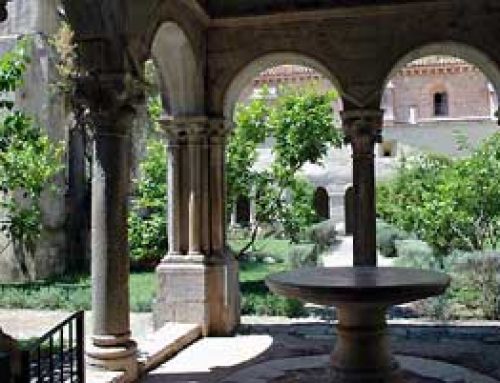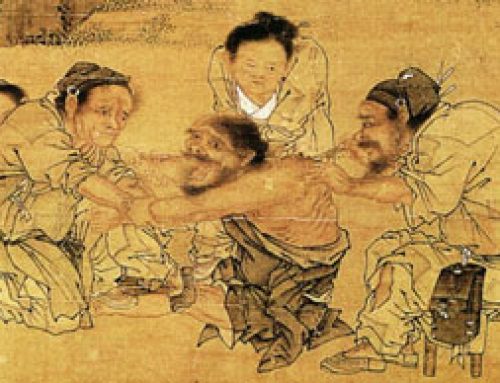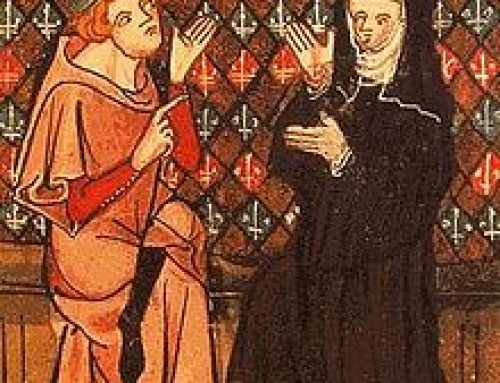
Medieval games: Women playing chess
Early medieval games: Dice, checkers, chess
The games of medieval Europe were mainly the same as those of Egypt, Greece, and Rome: dice, knucklebones, marbles, checkers. But there were some new games, too. In the Middle Ages, chess came to Europe from the Islamic Empire. When the Arabs took over Spain, in 711 AD, they brought chess with them, and it began to spread from there to the rest of Europe.
History of dice games
Where does chess come from?
Games in the Roman Empire
All our medieval Europe articles

Men playing cards England, 1340s (now in the British Library)
Playing cards join medieval games
Several hundred years later, in the 1300s AD, playing cards also finally reached Europe. A lot of cities banned playing cards at first, because people used them for gambling. After a while cities allowed cards. The first European cards were hand-painted, but soon they learned to use Chinese block-printing to make the cards cheaper.
History of playing cards
History of printing
Children’s toys: dolls and whistles
We also see more children’s toys from this time: whistles and little dishes and dolls. People didn’t sit still all the time- they liked to go swimming outside in ponds and rivers, too.
Medieval swimming

Men and women swimming in a pond (Tres Riches Heures du duc de Berry, 1400s. Now in Chantilly)
This picture of a seesaw from a medieval manuscript shows us not only that people in the Middle Ages used seesaws, but also that they had improved them from the time of ancient Greece. This one has a bolt through it in the middle to keep it straight, so it can’t wobble from side to side. That’s a big safety improvement over the ones we see from ancient Greece. In addition, these monkeys seem to think it’s normal to sit on a seesaw, as we do, but in ancient Greece the girls are standing and jumping.
See Greek seesaws and swings

Two monkeys riding a medieval seesaw. thanks to Eric Wade (Beinecke Library, MS 404, f. 131v)
Spectator sports in the Middle Ages
As for spectator sports, the gladiatorial games of the Roman Empire ended with the fall of Rome. In the Christian era, men no longer fought men to the death in the arenas.
But many similar entertainments survived and flourished. In the old amphitheaters, many of which people were still using, men kept on fighting animals: bears and bulls were the most popular of these, because they were the most dangerous. You can still see bull-fights today in Spain (and in Mexico), and they are still fought in amphitheaters. And people who had been convicted of crimes kept on being executed as entertainment.
Horse-racing and chariot-racing in the Middle Ages
In the old circuses, also, horse-racing and chariot-racing continued to be popular for a long time. This was especially true in Constantinople, where the charioteers (the drivers) were divided into teams (the Blues, the Greens, the Whites, and the Reds, though the Blues and the Greens were the most important) and which team you rooted for was tied to your politics and your religion, and often led to violent riots and murders in the circus and in the streets.
Where do horses come from?
Justinian and the Nika riots
But on a smaller scale, horse-racing continued in Spain and Italy also, throughout the Early Medieval period. You can still see a medieval horse-race today at the Palio in Siena, which is held every year.
Medieval tournaments

Roland jousting (Chartres Cathedral, France, 1200s AD)
Medieval European people replaced the old gladiatorial combats with the tournament, in which armed and armored knights fought each other for prizes, and for the entertainment of the king and queen and the public. Tournaments were different from the old gladiatorial games in two ways. First, they were not intended to end in death, though men did sometimes get killed anyway. Second, tournaments were fought by rich men, not by slaves and poor men. Still, they presented men fighting each other for entertainment, just as the older gladiatorial games had.
Making chainmail: a project
Did tournaments come from Central Asian polo games?
These tournaments probably were influenced by the popular Islamic sport of polo, which was invented in Uzbekistan around the time of the Parthians, and became common in West Asia around 800 BC, in the time of the Abbasid Empire. Maybe the popularity of polo encouraged the people who organized tournaments to emphasize fighting on horseback, rather than on foot as the gladiators did.
Islamic games
Central Asian games
Learn by doing: medieval tournaments
More about medieval swimming
More about dice games
Bibliography and further reading about medieval games:





O my gosh it’s just a painting deal with it!
g
hi
what up
i like the naked photo
It’s really just a photo of a painting.
do
But i honestly really d respect you sorry for all of the confusion
sorry my mind just runes wild with things and that is one of them oh yah and i am in 7th grade and my mind is something else
it is just the picture it stickes out from the others
Try to think of it as a painting: it’s a photograph of watercolors on paper, not real people.
the people swimming without clothes are inoppropiate
I just think it’s funny that you think people swimming without clothes is bad, but people killing animals and killing each other in the tournament is fine.
some of these are inappropriate
Do you mean that people are gambling, or that people are swimming without their clothes on? I think swimming naked is a lot better than torturing animals or fighting tournaments as a kind of game :)
[…] quatr.us – medieval games […]
Thanks for choosing us for your list!